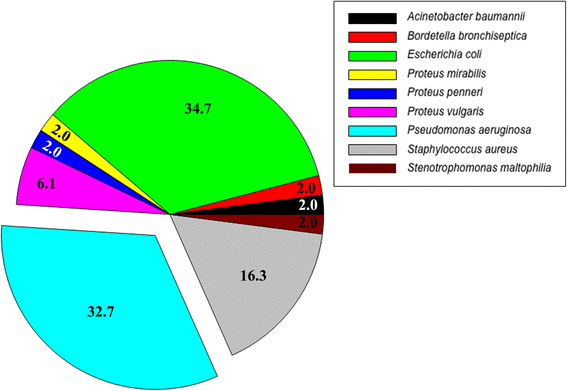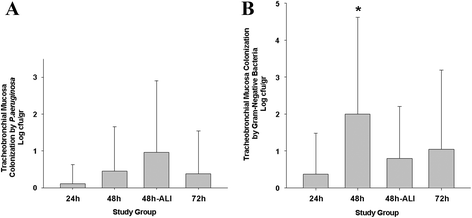Endotracheal tube biofilm translocation in the lateral Trendelenburg position
- PMID: 25887536
- PMCID: PMC4355496
- DOI: 10.1186/s13054-015-0785-0
Endotracheal tube biofilm translocation in the lateral Trendelenburg position
Abstract
Introduction: Laboratory studies demonstrated that the lateral Trendelenburg position (LTP) is superior to the semirecumbent position (SRP) in the prevention of ventilator-associated pulmonary infections. We assessed whether the LTP could also prevent pulmonary colonization and infections caused by an endotracheal tube (ETT) biofilm.
Methods: Eighteen pigs were intubated with ETTs colonized by Pseudomonas aeruginosa biofilm. Pigs were positioned in LTP and randomized to be on mechanical ventilatin (MV) up to 24 hour, 48 hour, 48 hour with acute lung injury (ALI) by oleic acid and 72 hour. Bacteriologic and microscopy studies confirmed presence of biofilm within the ETT. Upon autopsy, samples from the proximal and distal airways were excised for P.aeruginosa quantification. Ventilator-associated tracheobronchitis (VAT) was confirmed by bronchial tissue culture ≥3 log colony forming units per gram (cfu/g). In pulmonary lobes with gross findings of pneumonia, ventilator-associated pneumonia (VAP) was confirmed by lung tissue culture ≥3 log cfu/g.
Results: P.aeruginosa colonized the internal lumen of 16 out of 18 ETTs (88.89%), and a mature biofilm was consistently present. P.aeruginosa colonization did not differ among groups, and was found in 23.6% of samples from the proximal airways, and in 7.1% from the distal bronchi (P = 0.001). Animals of the 24 hour group never developed respiratory infections, whereas 20%, 60% and 25% of the animals in group 48 hour, 48 hour-ALI and 72 hour developed P.aeruginosa VAT, respectively (P = 0.327). Nevertheless, VAP never developed.
Conclusions: Our findings imply that during the course of invasive MV up to 72 hour, an ETT P.aeruginosa biofilm hastily colonizes the respiratory tract. Yet, the LTP compartmentalizes colonization and infection within the proximal airways and VAP never develops.
Figures





References
Publication types
MeSH terms
LinkOut - more resources
Full Text Sources
Other Literature Sources

